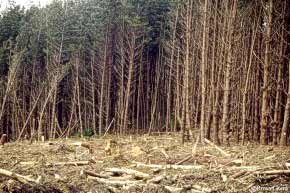|
|
|
High
volume production regimes

To maximise timber volume production, intensive
site preparation and high stocking rates are used to encourage
early canopy closure and to generate high basal areas. This
high level of competition has the advantage of minimising each
tree’s canopy area thereby reducing the size of the branches
and ensuring that most of the wood is produced in the stems.
The most appropriate initial spacing is determined from knowing
the mean tree diameter required for economical harvesting and
processing, and the likely basal area at the time of harvest.
For example, if the basal area of a eucalypt plantation at age
ten is expected to be 20 square metres per hectare, and the
farmer would like the mean tree diameter to be 20 centimetres,
the final stocking rate would need to be about 640 stems per
hectare. Allowing for some losses, the farmer might choose to
plant 700 stems per hectare, spaced at approximately 3.5 x 4.0
metres. On a high quality site, where the final basal area might
be expected to reach 30 square metres per hectare, the same
mean tree diameter would require 955 stems per hectare. In this
case an initial stocking rate of 1111 stems per hectare, spaced
at approximately 3.0 x 3.0 meters might be used.
Maximum tree height and the basal area are largely a function
of site quality so only the best quality sites are able to achieve
very high volume yields. Sites with cool climates and deep fertile
soils that receive more than 1000 millimetres rainfall per year
are ideal and excellent production levels are possible. However,
with many more marginal sites being planted to pulpwood plantations,
it is common to find that although early growth is excellent
the plantations soon "hit the wall" as basal area
and height reach their limit. When this happens, the growth
of any tree in the stand must be compensated for by the death
of others. Unfortunately, many plantations reach their limit
at an early age with little prospect of commercial pulpwood
production.
Back to top
|
|
